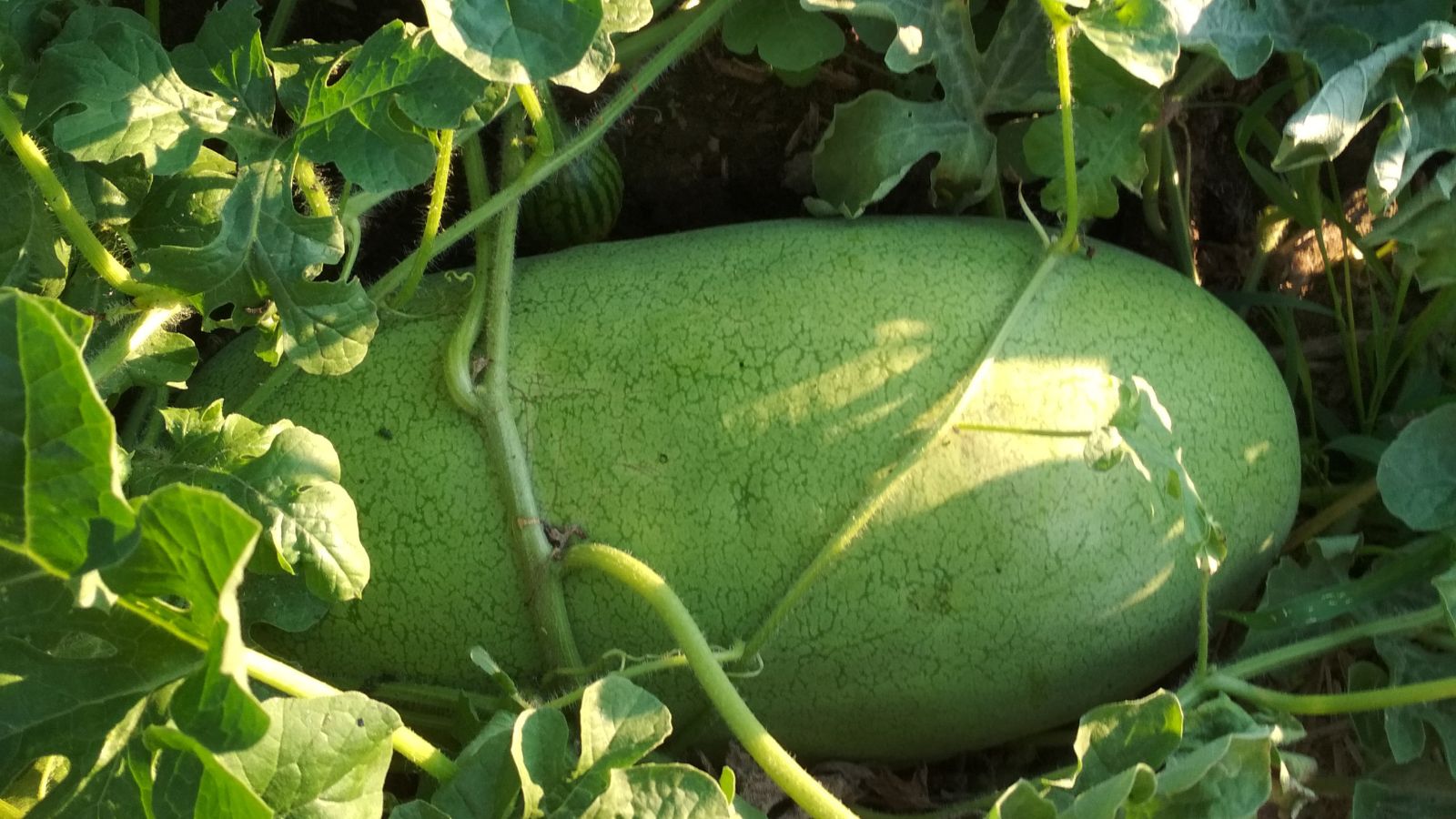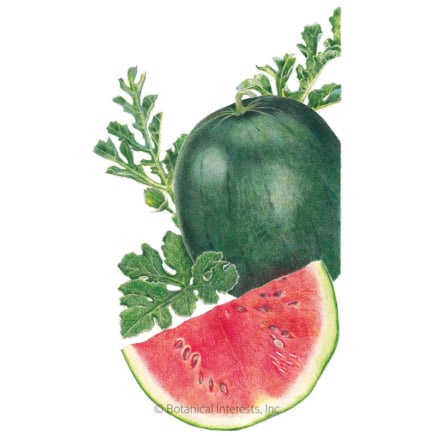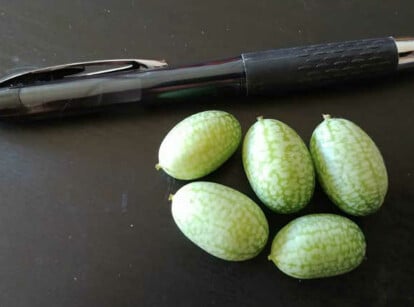How and When To Harvest Watermelons For Peak Sweetness
If you’re growing your own watermelons (or even selecting them at the market), you appreciate the importance of picking them at peak ripeness. Fully ripe watermelons develop sweetness, flavor, color, and texture on the vine. Learn what to look for to achieve the best time to harvest the sweet rounds with gardening expert Katherine Rowe.

Contents
There’s nothing quite like a chilled melon slice to revive a summer afternoon. A juicy watermelon is full of sweet, refreshing flavor, vitamins, and antioxidants, but it must be harvested at the right time to ensure proper ripeness.
Melon harvesting is notoriously mysterious, but it doesn’t have to be. With a few simple tips, you can figure out the best time to harvest your watermelons in the specific timeframe for prime sweetness.
Here, we’ll explore what to look for in the perfect pick, how to determine ripeness, and ways to preserve the bounty. Nurturing these long-maturing beauties is worth the effort (and wait).
Watermelon Basics

Watermelons, Citrullus lanatus, are native to North Africa and have wild ancestors in southern Africa and the Kalahari Desert. The drought-tolerant ancestors weren’t necessarily sweet, but they contained water. They made their way to Egypt, where cultivation began for improvements in water content and sweetness.
Fascinatingly, ancient watermelons appear in tombs in paintings and physical seeds. The crop later appears in historical references in Israel, Ancient Rome, China, and Europe.
Innovations continue today. Watermelon types include standard, icebox, seedless, bush, and early maturing. Standards are the ample beauties to serve a crowd. Icebox became the first to fit in an icebox—the more diminutive melons became a cool treat for farmers on their breaks from the field. Seedless are newer cultivars that avoid the hassles of seed-spitting, and bush are smaller plants with a non-vining habit. Early maturing are ready to harvest in fewer days.
Watermelons are 92% water. They’re part of the Cucurbitaceae family, along with cucumbers, squash, pumpkin, and other melons. As such, they’re susceptible to the same pests and diseases, so it’s best to separate the group when practical. Opt for pollinator-attracting and companion plants to promote health and pollination.
The melons are fun additions to the home garden in full-size or compact forms. They grow well in the ground and vertically, depending on the cultivar. Optimal growing conditions include:
- Full sun (six plus hours of sunlight daily)
- Well-draining, sandy loams
- Slightly acidic to neutral soil with a pH near 6.8
- Warm conditions (sow seeds when soil temps reach 65℉ or higher)
- One to two inches of water per week (rainfall and irrigation)
Timing the Harvest

There’s a sweet spot for harvesting watermelons with maximum flavor and delectable texture. While some fruits continue to ripen after picking, watermelons ripen on the vine. They won’t continue to develop flavor or increase sugars post-harvest.
It’s essential to pick them ripe and ready for optimal quality. The advantage is that fruits that don’t continue to ripen usually have a longer shelf life.
To gauge readiness, count out the days to mature fruits from your sowing date. The seed packet indicates this as “days to maturity” or “days.” The melons usually mature in 65 to 100 days, depending on the selection and weather. Maturity is about 35 to 45 days after flowering.
July is National Watermelon Month in the U.S., though harvest times vary depending on the cultivar and climate. Small varieties may mature more quickly than large selections.
Knowing When To Pick
When to harvest depends on a few key traits. The main characteristics are color, stem qualities, and a sound or “thump” factor.
Color

The best indicator of ripeness is color. Look for the color of the “ground spot,” the belly or underside where the melon touches the ground. When ripe, this patch transitions from greenish-white to yellow or creamy white. Opting for a yellowing fruit may be counterintuitive, but this is the most visible sign of ripeness.
On dark green melons and striped melons, the ground spot will be deep to buttery yellow. On light green-skinned varieties, the spot will be light yellow. However, if your melons are hanging and are not lying on the soil, they won’t have a ground spot.
This ground spot differential is clear among dark green varieties but less so on fruits with light green skins. Use the color test in combination with other ripening characteristics.
Shiny skin may also lose its luster. The skin becomes more dull and rough when ripe.
Stem

Ripe, ready-to-harvest watermelons have a brown, withered tendril or “pigtail” stem that connects them to the main vine. This browning shows that the fruit is mature and no longer twining and clinging.
The caveat is that some varieties present brown tendrils before they fully develop. The stems may brown seven to ten days before maturity. Specialty and heirloom varieties include ‘Crimson Sweet,’ ‘Sugar Baby,’ ‘Starlight,’ and ‘Yellow Doll,’ among others.
Overripe watermelons have brown tendrils, too. Try to catch the melons as the stems turn and use the other indicators in tandem.
Thump

The last assessment for when to harvest relates to feel. The melon should feel weighty and may plump at the blossom end. The thick skin will be firm and resist a fingernail poke. Fruits that “give” when pressed are too soft and may be overripe.
When tapped, it should make a “thump” noise. This is challenging to discern, takes practice, and isn’t always accurate. A ripe watermelon should sound hollow and dull with the tap of a finger. Unripe melons sound more metallic with a lighter tone.
How To Pick

To pick the melons, cut them from the main vine with sharp pruners or a blade. They don’t reach “full slip,” or the tendency to pull easily from the vine. Clipping is necessary, as twisting or pulling can injure the primary vine. When cutting, leave two inches of stem attached to the melon.
Check for soft spots, rot, bruising, or pest damage, and toss those that aren’t viable. Then, bring ready-to-eat selections indoors to store.
Storage

With the perfectly ripe fruit in hand, decide your preferred storage method. The whole melons last at room temperature for about one week and in the refrigerator for two to three weeks. Cut and chill the slices for grab-and-go refreshment.
The large fruits are sensitive to ethylene, a gas some fruits produce during the ripening process. To extend their shelf life, keep them separate from cantaloupe, tomatoes, bananas, and apples.
Sometimes, there are too many watermelons and too little time to enjoy or share them all. Depending on the variety, they weigh between 6 and 50 pounds, and that’s a lot of melon. Freezing them brings a lasting treat. Begin with ripe options for the best flavor.
Flash-freeze the fruit by cutting away the rinds and removing the seeds. Slice or cut the flesh into pieces. Arrange them on a parchment-lined baking sheet and freeze them for a few hours. Transfer them to an airtight container or freezer bag to freeze the lot.
Once thawed, the texture will differ from fresh-sliced melon. It will be softer (mushier) and less sweet but still refreshing. Use it in smoothies, slushies, gazpacho, or as a puree. Blend the fruit and pour it into ice cube trays to freeze as a puree. Place the tray in a freezer bag to preserve.
Don’t forget about the edible rinds. To maximize your crop, pickle the rinds to make them tender and flavorful. Homegrown varieties are usually thinner-skinned than commercial varieties, making them well-suited to the pickling jar.
Popular Varieties
With over 300 varieties available, winnowing down the selection is a fun and challenging decision. Here are a few favorites among many. Enjoy heirlooms, classic selections, hardy performers, and compact selections. Get creative with colorful variations like ‘Gold Doll’ and ‘Mountain Sweet Yellow.’
‘Crimson Sweet’

|
|
botanical name Citrullus lanatus ‘Crimson Sweet’ |
|---|---|
|
|
sun requirements Full sun |
|
|
height 6-10’ vines |
‘Crimson Sweet’ is a popular classic variety that produces 20 to 25-pound fruits. The pretty skins have green striping, and the flesh is rich red at maximum ripeness.
‘Crimson Sweet’ matures in about 85 days. The hardy grower is disease-resistant to the common fungal problems of Fusarium wilt and anthracnose. Round fruits grow 12 inches long and 10 inches across.
‘Sugar Baby’

|
|
botanical name Citrullus lanatus ‘Sugar Baby’ |
|---|---|
|
|
sun requirements Full sun |
|
|
height 6-10’ vines |
Sweet, delicious, and smaller than the classic oblong watermelon, ‘Sugar Baby’ packs all the juicy flavor in a more petite form. The rounds have firm, dark skin and weigh six to ten pounds.
Woodside Seed Growing Company of Rocky Ford, Colorado, introduced ‘Sugar Baby’ in its 1958 seed catalog. Amateur breeder Mr. Hardin of Oklahoma selected it from an heirloom Japanese variety, ‘Tough Sweets.’ ‘Sugar Baby’ is an improved icebox variety with deep red flesh and mottled black-green skin.
In addition to its sweet flavor, ‘Sugar Baby’ is an early maturing watermelon, ready to harvest about 80 days after planting. Wait to sow seeds until at least one or two weeks after the final frost.
One interesting thing to note: ‘Sugar Baby’ does not always produce a ground spot, and it gets even sweeter if you cut off its water supply 7-10 days before harvest. As your tendril starts to dry out, stop watering the plant for the sweetest flavor!
‘Charleston Gray’

|
|
botanical name Citrullus lanatus ‘Charleston Gray’ |
|---|---|
|
|
sun requirements Full sun |
|
|
height 6-10’ vines |
This still-favorite heirloom is from a 1950s USDA agricultural station in Charleston, South Carolina. Renowned breeder Charles Andrus developed ‘Charleston Gray’ to be the first variety to resist Fusarium wilt and anthracnose.
The skins are powdery gray-green to protect the melons from the intense southern sun. At harvest, these heavy oblong watermlons average 22 to 26 inches long and weigh 25 to 35 pounds.
The vines yield one to two large fruits. Their flavor is sweet and crisp, and the flesh is bright red.
Frequently Asked Questions
Do watermelons on the same plant ripen at the same time?
No, fruits can mature at different rates. Watermelons begin to develop fruits when insects pollinate their flowers. They mature about 35 to 45 days after flowering. While the ripening time on the same plant will overlap based on flowering and production, it will vary based on when the bees visit the male and female flowers. Check regularly when fruits near maturity for optimum ripeness.
Is it normal for watermelons to take a long time to develop fully?
These cucurbits are slow-growing. They rely on warm summer days to grow into hefty fruits with thick skins. Depending on the variety, they typically develop fully within 65-100 days. July and August are prime watermelon harvest months.
How many watermelons does one plant produce?
One plant usually yields two to four watermelons. This varies depending on the variety and factors like climate and growing conditions. Pinching the tip of the main vine when plants are one foot long encourages side shoots for more fruits.












